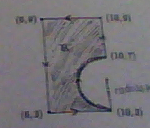cloudmaster
New member
- Joined
- Dec 22, 2014
- Messages
- 2
Hi! I am currently in a Multi-Variable (Calculus 3) class and we are on the unit with line and surface integrals. I am a bit confused with the following problem:
Let C be the closed path in the xy plane consisting of the four line segments and a half circle with points (6,3), (10,3), (10,7), (10,9), (6,9), and back to (6,3).
**The shape is essentially a box, with a semi-circle cutting into the rectangle from (10,3) to (10,7). Below is a sketch of it **

Evaluate: Integral (y/x+lny)dx + (ln(xy) +x/y -3x)dy
The first thing I tried was Green's Theorem, since this is a closed integral in a counterclock-wise direction. I said P= (y/x+lny) and Q= (ln(xy) +x/y -3x)
Thus, P(y)= 1/y + 1/y and Q(x)= 1/x +1/y -3
Then since Greens uses the double integral of Q(x) - P(y), I attempted to evaluate the integral over 6<x<10 and 3<y<9 (The bounds of the rectangle).
My plan is to first evaluate over the entire rectangle, and then evaluate over the semi-circle and then subtract the semi-circle from the rectangle.
I was wondering particularly:
Am I approaching this problem correctly? (With Greens?)
If I can use greens, how do I take the semi-circle into account?
I am actually super confused and have been staring at this problem for a while...
Thank-you to any thoughts/help!
Let C be the closed path in the xy plane consisting of the four line segments and a half circle with points (6,3), (10,3), (10,7), (10,9), (6,9), and back to (6,3).
**The shape is essentially a box, with a semi-circle cutting into the rectangle from (10,3) to (10,7). Below is a sketch of it **

Evaluate: Integral (y/x+lny)dx + (ln(xy) +x/y -3x)dy
The first thing I tried was Green's Theorem, since this is a closed integral in a counterclock-wise direction. I said P= (y/x+lny) and Q= (ln(xy) +x/y -3x)
Thus, P(y)= 1/y + 1/y and Q(x)= 1/x +1/y -3
Then since Greens uses the double integral of Q(x) - P(y), I attempted to evaluate the integral over 6<x<10 and 3<y<9 (The bounds of the rectangle).
My plan is to first evaluate over the entire rectangle, and then evaluate over the semi-circle and then subtract the semi-circle from the rectangle.
I was wondering particularly:
Am I approaching this problem correctly? (With Greens?)
If I can use greens, how do I take the semi-circle into account?
I am actually super confused and have been staring at this problem for a while...
Thank-you to any thoughts/help!
